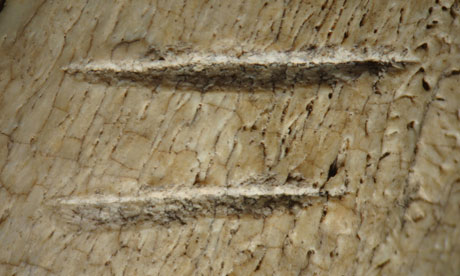| View previous topic :: View next topic |
| Author |
Message |
faceless
admin

Joined: 25 Apr 2006
|
 Posted: Thu Feb 26, 2009 11:57 pm Post subject: Earliest human footprints found Posted: Thu Feb 26, 2009 11:57 pm Post subject: Earliest human footprints found |
 |
|
|
|
 Earliest 'human footprints' found
Earliest 'human footprints' found
The earliest footprints showing evidence of modern human foot anatomy and gait have been unearthed in Kenya. The 1.5-million-year-old footprints display signs of a pronounced arch and short, aligned toes, in contrast to older footprints. The size and spacing of the Kenyan markings - attributed to Homo erectus - reflect the height, weight, and walking style of modern humans. The findings have been published in the journal Science.
The footprints are not the oldest belonging to a member of the human lineage. That title belongs to the 3.7 million-year-old Australopithecus afarensis prints found in Laetoli, Tanzania, in 1978. Those prints, however, showed comparatively flat feet and a significantly higher angle between the big toe and the other toes, representative of a foot still adapted to grasping. Exactly how that more ape-like foot developed into its modern version has remained unclear.
The fossil record is distinctly lacking in foot and hand bones, according to lead author Matthew Bennett of Bournemouth University, UK. "The reason is that carnivores like to eat hands and feet," Professor Bennett told BBC News. "Once the flesh is gone there's a lot of little bones that don't get preserved, so we know very little about the evolution of hands and feet on our ancestors."
The footprints were found near Ileret in northern Kenya. The site, on a small hill, is made up of metres of sediment which the researchers carefully cleared away. What they found was two sets of footprints, one five metres deeper than the other, separated by sand, silt, and volcanic ash. The team dated the surrounding sediment by comparing it with well-known radioisotope-dated samples from the region, finding that the two layers of prints were made at least 10,000 years apart.
Another critical feature that the series of footprints makes clear is how Homo erectus walked. There is evidence of a heavy landing on the heel with weight transferred along the outer edge of the foot, progressing to the ball of the foot and lifting off with the toes. "That's very diagnostic of the modern style of walking, and the Laetoli prints don't give that same character," Professor Bennett said.
The finding is a critical clue for mapping out the evolution of modern humans, both in terms of physiology and also how H. erectus fared in its environment. H. erectus was a great leap in evolution, showing increased variety of diet and of habitat, and was the first Homo species to make the journey out of Africa. "There's some suggestion out there that Homo erectus was able to scour the landscape for carcasses and meat...and was able to get there very quickly, had longer limbs and was much more efficient in terms of long distance travel," Professor Bennett added. "Now we're also saying it had an essentially modern foot anatomy and function, which also adds to that story.
---------------- |
|
| Back to top |
|
 |
faceless
admin

Joined: 25 Apr 2006
|
 Posted: Wed Aug 11, 2010 6:50 pm Post subject: Posted: Wed Aug 11, 2010 6:50 pm Post subject: |
 |
|
|
|
 Bone discovery pushes date for first use of stone tools back 1m years
Butchered bones found near site of 'Lucy', a probable human ancestor, who lived 3.2m years ago
Bone discovery pushes date for first use of stone tools back 1m years
Butchered bones found near site of 'Lucy', a probable human ancestor, who lived 3.2m years ago
Ian Sample,
guardian.co.uk,
11 August 2010
The ancestors of early humans used stone tools to butcher animal carcasses nearly 1m years earlier than previously thought. Archaeologists revised the date after spotting distinctive cut and crush marks made by stone tools on animal bones dating to 3.4m years ago. The remains, including a rib from a cow-like creature and a thigh bone from an animal the size of a goat, were recovered from riverbed sediments in Dikika in the Afar region of northern Ethiopia during an expedition last January. The marks show where stone tools were used to slice and scrape meat from the carcasses and where the bones were crushed to expose the nutritious marrow inside.
The discovery suggests meat was on the menu far back in our evolutionary history, and long before the arrival of the first human species, Homo habilis, 2.3m years ago. "We were just walking along when we discovered the two bones," said Shannon McPherron, an archaeologist at the Max Planck Institute for Evolutionary Anthropology in Leipzig. "We picked up the rib fragment, flipped it over and there were these two, clear marks. Soon after, we found the second bone, also with a lot of marks on it. Right away we knew we had something potentially important."
Until now, the oldest evidence of stone-tool use was a haul of more than 2,600 stone flakes estimated to be 2.5m years old that was discovered in another part of Ethiopia in 1997. These tools had been shaped to make sharp cutting edges, but in Dikika, the stones were most likely used as they were found. The butchered bones were discovered close to where the skeleton of a probable human ancestor, nicknamed Lucy, was found. Lucy belonged to a species called Australopithecus afarensis and lived in the region around 3.2m years ago. At the time, the region was warm and wet, with patches of grassland and heavily forested areas populated with early forms of giraffes, monkeys, elephants and rhinos.
"Now, when we imagine Lucy walking around the east African landscape looking for food, we can for the first time imagine her with a stone tool in hand looking for meat," said McPherron. The skeleton of another female, "Selam", was found 200 miles away.
Detailed analysis of the cut marks on the bones show they differ substantially from tooth and claw marks that can be left by predators. One of the marks was embedded with a small fragment of stone, according to a report in the journal, Nature. The use of simple stone tools to remove meat and marrow marks a crucial moment in the human story. As the ancestors of early humans turned to meat for sustenance, they were able to grow larger brains which in turn enabled them to make more sophisticated tools.
"These bones may take us to the very beginning of that process," said Chris Stringer, head of human origins at the Natural History Museum in London. "What we need from these sites now are evidence of the stone tools themselves, so we can see if they were manufactured or were natural stones that happened to be used for butchery," he added.
Lucy and others of her species probably carried natural stone tools around with them to use when they encountered a dead animal. "It's not a trivial thing to leave the trees behind, wander out onto this open landscape and start removing flesh and marrow from a carcass. Those same carcasses were attracting carnivores that look at these early hominins as a meal, so they were taking a major risk," said McPherron. |
|
| Back to top |
|
 |
|
|
|
|
You cannot post new topics in this forum
You cannot reply to topics in this forum
You cannot edit your posts in this forum
You cannot delete your posts in this forum
You cannot vote in polls in this forum
You cannot attach files in this forum
You cannot download files in this forum
|
Couchtripper - 2005-2015
|





